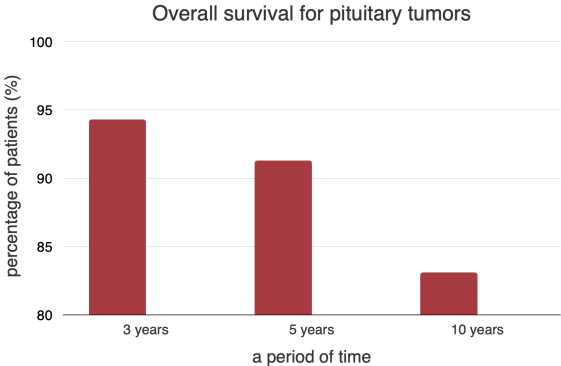Pituitary Gland Tumor Guide

Every sixth primary brain tumor is a pituitary gland tumor.
About 25% of people don't know they have small tumors in their pituitary glands.
94 of 100 pituitary adenomas removed surgically were treated only with the operation.
97% of people with a diagnosis of pituitary gland tumor will live for at least five years.
 What we should know about the pituitary gland
What we should know about the pituitary gland
 At the base of the brain is the pituitary gland (hypophysis). It is a "master" endocrine gland divided into two lobes and makes hormones to control main body functions, including growth, metabolism, and reproduction.
At the base of the brain is the pituitary gland (hypophysis). It is a "master" endocrine gland divided into two lobes and makes hormones to control main body functions, including growth, metabolism, and reproduction.
Here are the hormones that “the master gland” makes:
- Adrenocorticotropic hormone (ACTH): controls how much cortisol the adrenal glands produce and how much cortisol they release. It helps control stress, metabolism, and immune function.
- Follicle-stimulating hormone (FSH): Helps to control when women have their periods and when men make sperm.
- Luteinizing hormone (LH): A second hormone that helps control women’s periods and how much testosterone men make.
- Prolactin: It helps women who are breastfeeding make more breast milk.
- Growth hormone (GH): It helps cells grow and divide.
- Thyroid-stimulating hormone (TSH): controls the production and release of thyroid hormones, which help control metabolism.
- Oxytocin is a hormone that helps with both giving birth and breastfeeding.
- Vasopressin, also called antidiuretic hormone, helps keep the body's water balance in check.
A broken pituitary gland can cause health problems depending on which hormone is affected.
 What is a pituitary gland tumor?
What is a pituitary gland tumor?
A tumor is an abnormal enlargement of pituitary cells. Because of the disease, the gland produces too little or too much hormone, causing many health issues.
Pituitary adenomas are tumors that grow in front of the gland. Some tumors will be cancerous. Because the pituitary gland is close to the brain, oncologists sometimes call it a "brain tumor."
The groups are based on their size or the cell they came from.
Due to the size, pituitary adenomas are divided into:
- microadenomas (less than 10 mm),
- macroadenomas (10-40 mm),
- Giant tumors (more than 40 mm).
Depending on the involved cells in the types of tumors, they are as follows:
- Most adenomas are null cell adenomas, which don't produce hormones. When the growth gets to a specific size, it can give you headaches and make it hard to see. A tumor kills normal pituitary cells in an enlarged pituitary gland, which causes symptoms caused by a drop in hormone production.
- Prolactin-secreting adenoma: High prolactin levels lower sex hormones, which can cause infertility, low libido, and osteoporosis in both men and women. Men have erectile dysfunction and gynecomastia (enlarged man's breast tissue), while women have no periods or breast growth.
- GH-secreting adenoma (acromegaly): Symptoms include headaches, changes in vision, an increase in ring or shoe size, arthritis, carpal tunnel syndrome, and excessive sweating. In the clinic, people with this condition have rough facial features, frontal bossing, a big nose, prognathism, an oversized tongue, and skin tags. At the time of diagnosis, you may also have hypertension, cardiomyopathy, obstructive sleep apnea, and multiple colonic polyps.
- ACTH-secreting adenoma (Cushing disease) causes weight gain, muscle weakness, mood disorders, easy bruising, and multiple fractures. Clinical signs include a round face, fat on the front, ecchymosis, and purple lines on the stomach and armpits.
- Patients with an adenoma that makes TSH often have heart palpitations, irregular heartbeats, and weight loss. On the exam, they might shake and have a goiter.
 What are pituitary gland tumor risk factors?
What are pituitary gland tumor risk factors?
Several things can make you more likely to get a pituitary gland tumor:
- Age: People over 40 are more likely to have tumors in their pituitary glands.
- Family history: If someone in your family has a pituitary gland tumor, you may be more likely to get one yourself. Pituitary adenomas that run in families make up 5%.
- Gender: Women are more likely than men to have pituitary adenomas.
- Previous radiation exposure: People who have had radiation treatment to the head or neck may be more likely to get such a tumor.
- Some health conditions: Multiple endocrine neoplasia type 1, a genetic disorder that affects the endocrine system, may cause a pituitary gland tumor.
It's important to remember that having one or more of these risk factors doesn't mean a person will get a pituitary gland tumor. People who don't have any of these risk factors may still get it.
How to prevent pituitary adenomas?
There is no way to be sure that a pituitary gland tumor won't grow. But some things might make it less likely:
- Avoiding radiation: Lower your risk of getting a pituitary gland tumor by avoiding X-rays and CT scans when you don't need to.
- Eating a healthy diet: If you eat a lot of fruits, vegetables, and whole grains, you may be less likely to get a tumor.
- Keeping a healthy weight and avoiding tobacco and alcohol: pituitary gland tumor can be more likely if a person is overweight and consume tobacco and alcohol.
- Regular medical checkups can help your doctor find any problems with your pituitary gland early, which could mean you can start treatment sooner.
All these measures are generally thought to prevent all types of cancer. However, there is no evidence that they can 100% prevent pituitary gland tumors.
 What are pituitary gland tumor symptoms?
What are pituitary gland tumor symptoms?
In most cases, pituitary gland tumor does not cause any symptoms. As a result, they are not diagnosed in the early stages and usually are found during a brain scan.
Tumors in the pituitary gland cause a wide range of signs. Pituitary tumor symptoms depend on the damaged area of the gland and may vary from person to person. They rely on the pituitary gland tumor's size, where it is in the gland, and what hormones it makes. Some of the most common signs are:
- Headaches,
- Vision problems (such as double vision),
- Gaining or losing weight without trying,
- Changes in menstruation (periods) in women,
- Hair loss,
- Men lose hair on their faces and get breast tissue,
- Men with impotence or changes in how they act sexually,
- Fatigue,
- Dry skin,
- Cold and hot intolerance (feeling colder or hotter than others),
- Changes in mood,
- Trouble remembering things or focusing,
- Both physical growth and sexual development are slow in children.
It's important to remember that many of these pituitary gland symptoms can also be signs of other problems.
 Diagnostic tests
Diagnostic tests
Several tests help to diagnose:
- A neurologist performs the neurological examination. The doctors check reflexes, motor and sensory skills, balance, coordination, mental status, and other central nervous system functions. Also, the doctor asks about the patient's medical history and symptoms.
- Hormone tests in the lab show how the endocrine system works. Blood tests can measure the levels of hormones in the pituitary gland, and doctors may order to repeat them. Also, samples of saliva and urine may be taken.
- Imaging tests, such as an MRI or CT scan, create detailed pictures of the pituitary gland and the surrounding area and help to determine the size and location of the pituitary gland tumor. Before the scan, a special dye is injected. It makes the image clearer.
- An exam of the visual field can help because the pituitary gland is close to the optic nerves; if it gets bigger, it can pressure nerves. Each eye is tested on its own to see if it can see points of light. When a person has a pituitary gland tumor, the most common problem is that they can't see things at the edges of their field of vision.
- An ophthalmologic examination can check for changes in the eyes that the tumor may cause.
- A biopsy is when a doctor takes out a small piece of tissue to look at with a microscope. Other tests may show a tumor, but a biopsy is the only way to know precisely about a pituitary gland tumor. Most of the time, a biopsy is done as part of the surgery to remove the mass.
- A lumbar puncture, also known as a "spinal tap," is when cerebrospinal fluid is taken with the help of a needle to check for cancer cells, blood, or tumor markers.
Where to go to get proper treatment?
 Common treatment methods
Common treatment methods
Endocrinologists and neurosurgeons work closely together to develop a "patient-centered, individualized" plan for treating pituitary tumors.
The best way to manage pituitary tumors and their side effects are to treat them quickly. The following therapies are offered to those who have a pituitary adenoma:
- Drug treatment or systemic therapy is based on decreasing evaluated levels or replacing hormones in the body affected by the tumor. Most medicines are given through an IV or as pills or capsules. For example, doctors prescribe dopamine agonists (DA) for treating tumors that make prolactin, GH, and ACTH-secreting adenoma.
- The surgery helps remove the mass and some healthy tissue around it. It is the most common way to treat a pituitary gland tumor. During a craniotomy, a hole is made in the skull, and the surgeon can remove a tumor. Surgery is done about 5% of the time to remove a tumor from the pituitary gland.
- Radiotherapy with high-powered beams kills the pituitary gland tumor or stops its growth. Radiotherapy sends radiation to the area of the brain from outside the patient's body.
What clinics do we recommend?
 New treatment opportunities
New treatment opportunities
Because medical professionals have been employing particular therapies for an extended time, we now consider them the industry standard. And several of them are currently being tested in clinical settings; if they prove successful, they might one day be used to treat pituitary gland tumors.
- Inserting an endoscope into the nose through a cut performs endoscopic transsphenoidal surgery. It is done to examine structures inside the nose. The sphenoid bone is traversed to reach the pituitary gland tumor in the brain. An endoscope is a medical instrument with the shape of a tube and is very thin. It has a light, a viewing lens, and a tool that can remove tumor tissue.
- CyberKnife and GammaKnife are two advanced types of radiation therapy. They use concentrated beams of high-dose gamma radiation to target a brain region. They limit the radiation's impact on the remaining brain tissue. The treatment is less likely to cause damage to the pituitary gland tumor. Doctors can complete them in a shorter time. Additionally, it causes fewer adverse effects than other methods of cure. Because these procedures are minimally invasive, there is no chance of infection or other complications like those that are associated with surgery. They also cause less discomfort.
- Proton beams are the form of radiation applied in the process of proton treatment. Usually, it can give greater doses of radiation while also being more targeted than conventional radiotherapy. Because of this, there is a greater possibility that the surgeon will remove the pituitary gland tumor, but there is also a greater possibility that they will hurt normal hypophysis tissue.
The treatment of pituitary gland tumors is a new field of study. We still need to determine what causes them. We are looking for the most effective pituitary gland tumor treatments and how patients should have cared for.
Who has experience in the treatment of pituitary adenomas?
 Statistics and prognosis
Statistics and prognosis
The actual number of pituitary neoplasms can be much higher than the number of tumors found each year. Doctors have found that 1 in 4 people may have a pituitary tumor without knowing it. When doctors look at the brains of people (postmortem autopsy) or after they have died (MRI scan), they find small tumors in about 25%. They usually don't cause any symptoms or health problems. Because of this, very few of them are ever found.
Pituitary gland tumors are still poorly understood regarding how common, and likely they will spread. Pituitary adenomas were reported in the United States from 2004 to 2016 to the surveillance, epidemiology, and end results (SEER) database. 73% of people with pituitary adenomas were between the ages of 19 and 64. Surgical resection was done on 45% of patients, and surgery was the only treatment for 94%. Also, 4% of them got radiation therapy. There were 4.8 pituitary adenomas per 100,000 people, and 56% of those who got sick were women. At 3, 5, and 10 years, overall survival rates were 94.3%, 91.3%, and 83.1%. Due to the other source, the 5-year survival rate was 97%.

The more prolonged overall survival is linked to a younger age at diagnosis and a smaller tumor size.
When the brain is healthy, the body is healthy. If you or someone in your family is showing signs of cognitive impairment, don't wait to get in touch with the AiroMedical team to get personalized care. You can share your problems online with just one click and get a unique solution.
Just let us help.
References:
- Scientific Reports: Incidence, demographics, and survival of patients with primary pituitary tumors: a SEER database study in 2004–2016
- Oxford University Press: Diagnosis and Management of Pituitary Carcinomas
- American Society of Clinical Oncology (ASCO): Pituitary Gland Tumor: Latest Research
- American Cancer Society: Treating Pituitary Tumors
- National Cancer Institute: Pituitary Tumors Treatment (PDQ®)–Patient Version
- American Association of Neurological Surgeons: Pituitary Gland and Pituitary Tumors
- National Library of Medicine: Pituitary Adenoma

















